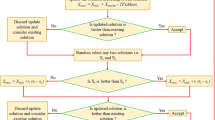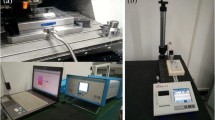Abstract
Improving machining performance with reduced power consumption is a big challenge for the manufacturer to reduce production cost. Since the dead metal zone (DMZ) directly affects the cutting forces, the present study aims to optimize the DMZ to reduce the cutting and thrust forces in the micro-milling of hardened AISI D2 steel using teaching–learning-based optimization technique (TLBO). Finite element model for DMZ geometry and mechanistic models for cutting and thrust forces are developed, integrated and estimated the cutting and thrust forces. The estimated forces are compared with experimental results and a good agreement found between them. In the next stage, process parameters (cutting speed and feed per tooth) and tool parameters (nose radius and rake angle) are optimized using TLBO technique to minimize DMZ geometry keeping the surface roughness (≤ 2 µm), tool wear (≤ 30 µm) and amplitude of cutter vibration (≤ 30 µm) as constraints. The optimal working condition is as follows: a spindle speed of 2225 rpm, a feed per tooth of 5.0 µm, and a nose radius of 7.6 µm and rake angle of 3.0°. Under the optimal working condition, side length of DMZ and DMZ angle is found as 13.8 mm and 5.74°, respectively, and the cutting and thrust forces are estimated as 3.27 and 2.37 N, respectively. These cutting and thrust forces are about 21.3–65.7 and 34.8–55.3%, respectively, less than the experimental results.









Similar content being viewed by others
Abbreviations
- ζ 1 and ζ 2 :
-
Slip-line angles (o)
- ρ :
-
Prow angle (o)
- Ø :
-
Shear angle (o)
- \(\theta\) :
-
Slip-line field angle (o)
- t c :
-
Chip thickness (mm)
- AD and DF:
-
Side lengths of DMZ (mm)
- r :
-
Nose radius (mm)
- F T :
-
Thrust force (N)
- \( \sigma_{{\text{f}}}\) :
-
Plastic flow stress (MPa)
- A, B, C, n and m :
-
Material constants
- \(T_{{{\text{room}}}}\) :
-
Room temperature (oC)
- S :
-
Spindle speed (rpm)
- Ra:
-
Surface roughness (µm)
- Y :
-
Amplitude of tool vibration (µm)
- α :
-
DMZ angle (o)
- γ :
-
Rake angle (o)
- δ :
-
Slip-line central fan angles (o)
- t u :
-
Uncut chip thickness (mm)
- AE :
-
Shear plane length (mm)
- w :
-
Width of cut (mm)
- F C :
-
Cutting force (N)
- k :
-
Shear flow stress (MPa)
- \(\frac{{\varepsilon^{o} }}{{\varepsilon_{0}^{o} }}\) :
-
Reference strain rate
- ε :
-
Plastic strain (MPa)
- \(T_{{{\text{melt}}}}\) :
-
Melting point (oC)
- F:
-
Feed/tooth (µm/tooth)
- VB:
-
Flank wear (µm
References
Venkatarao K (2019) Power consumption optimization strategy in micro ball-end milling of D2 steel via TLBO coupled with 3D FEM simulation. Measur 132:68–78
Wan L, Haddag B, Wang D, Sheng Y, Yang D (2018) Effects of friction conditions on the formation of dead metal zone in orthogonal cutting–a finite element study. Mach Sci Tech 22(6):934–952
Venkatarao K (2019) A study on performance characteristics and multi response optimization of process parameters to maximize performance of micro milling for Ti-6Al-4V. J All Comp 781:773–782
Wan L, Haddag B, Wang D, Sheng Y, Yang D (2018) Effects of friction conditions on the formation of dead metal zone in orthogonal cutting—a finite element study. Machi Sci Tech 22(6):934–952
Sahoo P, Patra K, Vishnu Kumar Singh, Gupta MK, Song Q, Mia M, Pimenov DY. Influences of TiAlN coating and limiting angles of flutes on prediction of cutting forces and dynamic stability in micro milling of die steel (P-20). J Mater Proc Techn 2020; 278:116500.
Movahhedy MR, Altintas Y, Gadala MS (2001) Numerical analysis of metal cutting with chamfered and blunt tools. J Manu fSci Eng 124(2):178
Karpat Y, Ozel T (2008) Mechanics of high speed cutting with curvilinear edge tools. Int J Mach Tool Manuf 48:195–208
Wan L, Wang D (2015) Numerical analysis of the formation of the dead metal zone with different tools in orthogonal cutting. Sim Mode Prac Theo 56:1–15
Afsharhanaei A, Rebaioli L, Parenti P, Annoni M (2018) Finite element modeling of micro-orthogonal cutting process with dead metal cap. Proc I Mech E Part B: J Eng Manuf 232(8):1351–1361
Murthy PBGSN, Sreenivasa Rao C, Venkata Rao K (2019) Experimental and 3D FEM-ANN based analysis and prediction of cutting forces, tool vibration and tool wear in boring of TI-6AL-4V alloy. Int J Aut Mech Eng 16(1):6146–6160
Prasad Babu GHV, Murthy BSN, Venkatarao K, Ratnam C (2017) Multi response optimization in orthogonal mill turning by analysing tool vibration and surface roughness using response surface methodology. Proc I Mech Eng Part B: J Eng Manuf 231(12):2084–2093
Hussain SJ, Srinivas J (2017) Analytical prediction of chatter stability of end milling process using three-dimensional cutting force model. J Braz Soc Mech Sci Eng 39:1633–1646
Yousefi S, Zohoor M (2019) Effect of cutting parameters on the dimensional accuracy and surface finish in the hard turning of MDN250 steel with cubic boron nitride tool, for developing acknowledged base expert system. Int J Mech Mat Eng 14:1
Prasad BS, Umamaheswararao J, Gopala KA (2017) Analysis of vibration signals to quantify displacement amplitude in the monitoring of vibration-assisted turning. Proc I Mech E, Part E: J Proc Mech Eng 233(1):35–47
Danil YP, Adel TA, Munish Kumar G, Erdakov IN, Soliman MS, Rayes MME (2020) Investigations of surface quality and energy consumption associated with costs and material removal rate during face milling of AISI 1045 steel. Int J Adv Manuf Tech 107(7–8):3511–3525
Saffaran A, Azadi Moghaddam M, Kolahan F (2020) Optimization of backpropagation neural network-based models in EDM process using particle swarm optimization and simulated annealing algorithms. J Braz Soc Mech Sci Eng 42:73
Zhang N, Shi Y (2019) Improvement of cutting force and material removal rate for disc milling TC17 blisk tunnels using GRA–RBF–PSO method. Proc I Mech E, Part C: J Mech Eng Sci 233(16):5556–5567
Cheema MS, Dvivedi A, Sharma AK (2013) A hybrid approach to multi-criteria optimization based on user’s preference rating. Proc I Mech E Part C: J Eng Manuf 227(11):1733–1742
George J, Manu R, Mathew J (2019) Multi-objective optimization of roundness, cylindricity and areal surface roughness of Inconel 825 using TLBO method in wire electrical discharge turning (WEDT) process. J Braz Soc Mech Sci Eng 41:377
Venkatarao R (2015) Teaching learning based optimization algorithm and its engineering application, 1st edn. Springer, New York (2nd chapter, ISBN: 3319227319 9783319227313)
Arrazola PJ, Ozel T, Umbrello D, Davies M, Jawahir IS (2013) Recent advances in modelling of metal machining processes. CIRP Ann: Manuf Techn 62:695–718
Fang N (2003) Slip-line modeling of machining with a rounded edge tool—part I: new model and theory. J Mech Phys Solids 51:715–742
Venkatarao K, Harish BB, Umasai VPV (2019) A study on effect of dead metal zone on tool vibration, cutting and thrust forces in micro milling of Inconel 718. J All Comp 793:343–351
Shi T, Ramalingam S (1991) Slip line solution for orthogonal cutting with a chip breaker and flank wear. Int J Mech Sci 33(9):689–704
Johnson GR, Cook WH (1983) A constitutive model and data for metals subjected to large strains, high strainrates and high temperatures. In: Proceedings of the 7th international symposium on ballistic, The Netherlands: The Hague, pp 541–547
Lotfi M, Farid A, Soleimanimehr H (2015) The effect of chip breaker geometry on chip shape, bending moment, and cutting force: FE analysis and experimental study. Int J Adv Manuf Tech 78(5–8):917–925
Szymon W, Radosław WM, Grzegorz MK, Niestony P (2018) Application of signal to noise ratio and grey relational analysis to minimize forces and vibrations during precise ball end milling. Prec Eng 51:582–596
Tingli C, Minyou C, Peter JF, Yan Z, Gan S (2017) A novel hybrid teaching learning based multi-objective particle swarm optimization. Neuro comp 222:11–25
Awale A, Inamdar K (2020) Multi-objective optimization of high-speed turning parameters for hardened AISI S7 tool steel using grey relational analysis. J Braz Soc Mech Sci Eng 42:356
Liu X, Zhang X, Wang D (2020) Numerical analysis of different cutting edge radii in hot micro-cutting of Inconel 718. Proc I Mech E, Part C: J Mech Eng Sci 234(1):196–210
Zheng G, Xu R, Cheng X, Zhao G, Li L, Zhao J (2018) Effect of cutting parameters on wear behavior of coated tool and surface roughness in high-speed turning of 300M. Measur 125:99–108
Venkatarao K, Murthy BSN, Mohan RN (2016) Experimental study on Tool Condition Monitoring in boring of AISI 316 stainless steel. Proc I Mech E Part B: J Eng Manuf 230(6):1144–1155
Shuang Y, Jin JL, Jiahua Z, Wang X, John M, Ding S (2020) Investigation of machining Ti-6Al-4V with graphene oxide nanofluids: tool wear, cutting forces and cutting vibration. J Manuf Proc 49:35–49
Wan L, Wang D (2015) Numerical analysis of the formation of the dead metal zone with different tools in orthogonal cutting. Sim Mod Prac Theo 56:1–15
Acknowledgements
This work (Major project) was supported by Science and Engineering Research Board, Department of Science and Technology, Government of India. Grant No.: SERB/F/1761/2015-16.
Author information
Authors and Affiliations
Corresponding author
Ethics declarations
Conflict of interest
The authors declare that they have no conflict of interest.
Additional information
Technical Editor: Lincoln Cardoso Brandao.
Publisher's Note
Springer Nature remains neutral with regard to jurisdictional claims in published maps and institutional affiliations.
Supplementary Information
Below is the link to the electronic supplementary material.
Rights and permissions
About this article
Cite this article
Babu, B.H., Rao, K.V. & Ben, B.S. Modeling and optimization of dead metal zone to reduce cutting forces in micro-milling of hardened AISI D2 steel. J Braz. Soc. Mech. Sci. Eng. 43, 142 (2021). https://doi.org/10.1007/s40430-021-02861-5
Received:
Accepted:
Published:
DOI: https://doi.org/10.1007/s40430-021-02861-5




